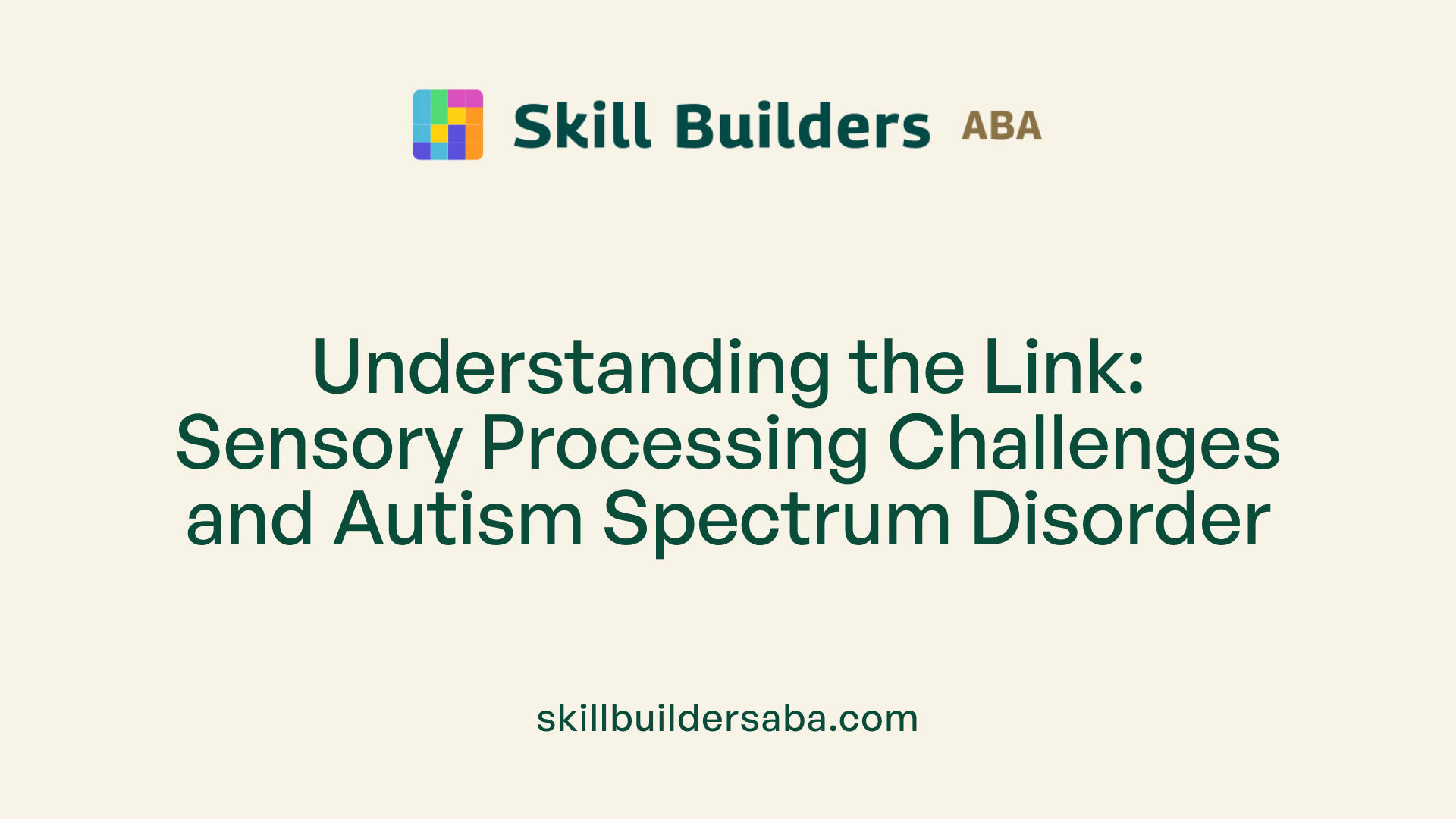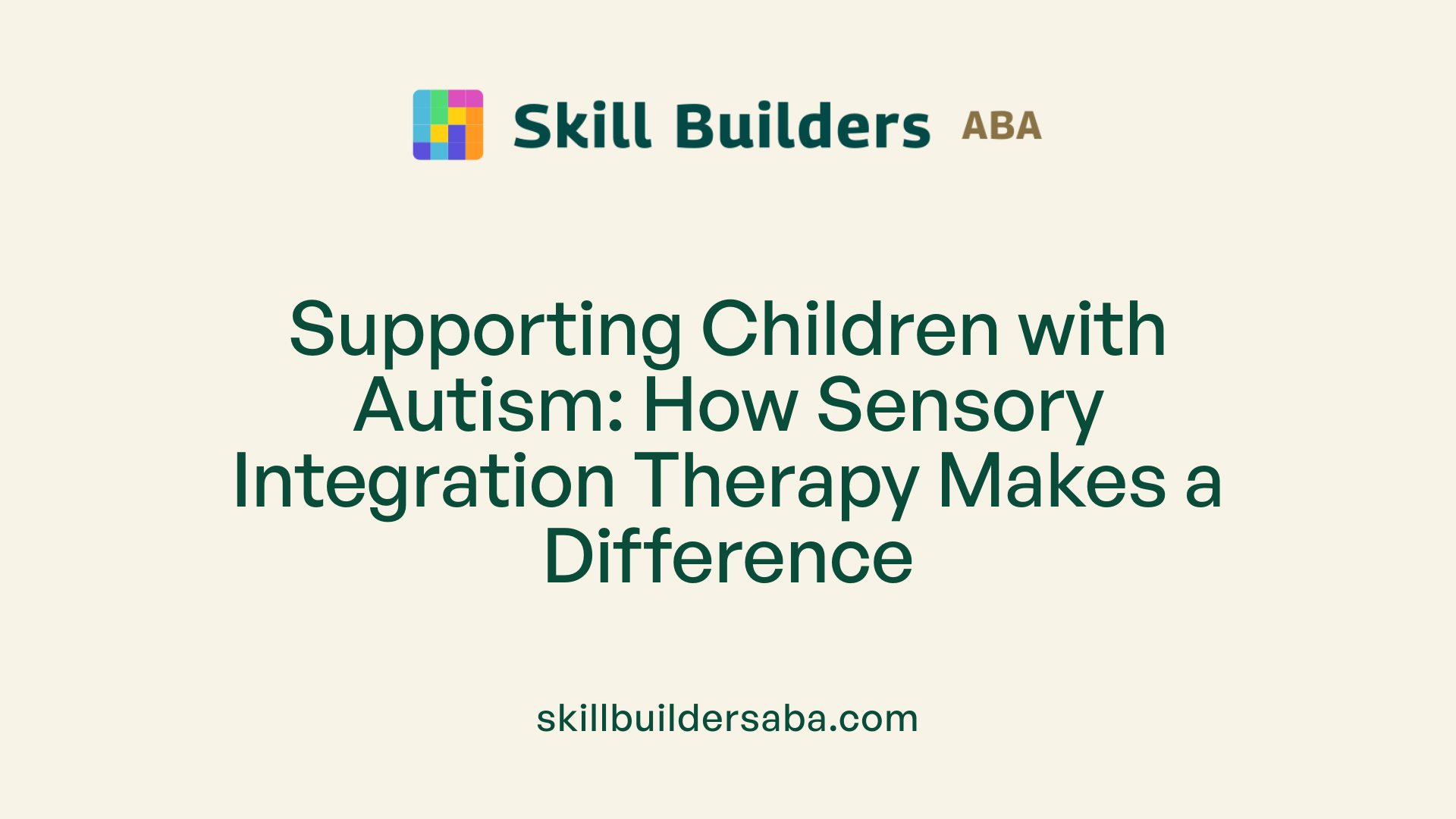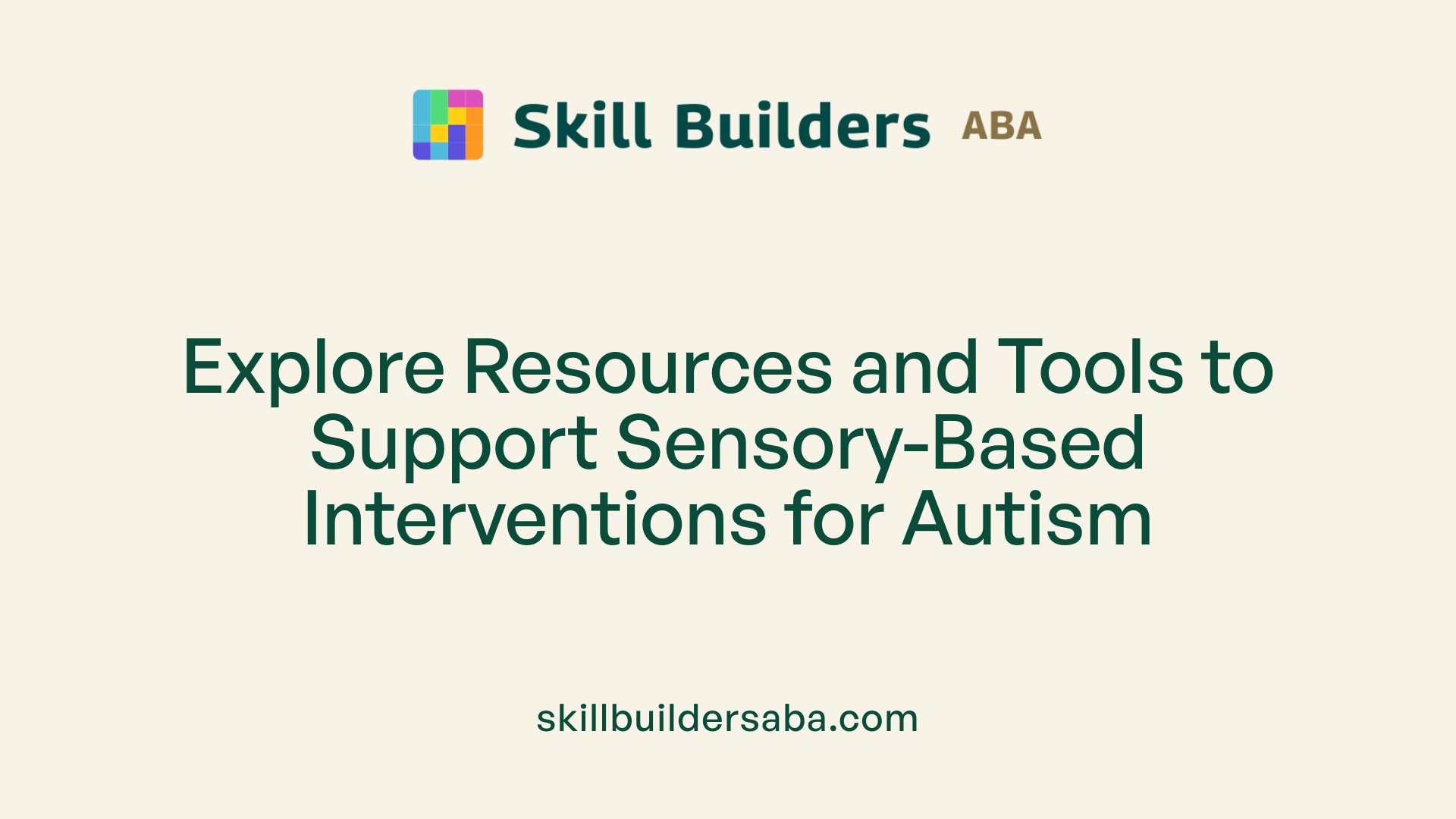Sensory Integration Therapy & Autism
Understanding the Role of Sensory Processing in Autism

Exploring Sensory Challenges and Therapeutic Approaches
Sensory processing difficulties are a core aspect of autism spectrum disorder (ASD), affecting how individuals interpret and respond to sensory stimuli. Sensory integration therapy (SIT), developed in the 1970s by Dr. A. Jean Ayres, offers a tailored, play-based approach designed to help children with these challenges. This article delves into what sensory integration therapy entails, its connection to autism, supporting scientific evidence, and practical resources to support children and their families.
What is Sensory Integration Therapy and How Does It Work?
What is sensory integration therapy and how does it work?
Sensory integration therapy (SIT), also called Ayres Sensory Integration (ASI), is an intervention designed to help children who have difficulties processing sensory information. It was developed by occupational therapist Dr. A. Jean Ayres in the 1970s based on the idea that sensory processing issues can affect learning and behavior.
SIT involves providing controlled, playful activities that stimulate the senses, such as swinging, bouncing, brushing, or deep pressure exercises. These activities target the vestibular (balance), tactile (touch), proprioceptive (body awareness), and other sensory systems. The goal is to help the child's nervous system become better organized so they can respond more appropriately to sensory stimuli.
During therapy, occupational therapists assess a child's sensory profile—whether they are hypo-sensitive (under-reactive) or hyper-sensitive (over-reactive)—and tailor activities to address specific needs. These activities often include swinging, climbing, tactile play, and movement-based exercises like crawling through tunnels or balancing on beams.
By engaging in these sensory-rich experiences, the therapy aims to improve motor skills, reduce stress, and promote better self-regulation. It also helps children become more adaptable to sensory inputs, which can enhance their behavior, social skills, and daily functioning.
Most practitioners conducting SIT are trained occupational therapists who use a variety of sensory tools and equipment, sometimes in specially equipped sensory gyms. The overall purpose is to facilitate neuroplasticity — the brain's ability to change and adapt — leading to improved sensory processing, less self-stimulatory behavior, and increased participation in everyday activities.
In summary, sensory integration therapy works by systematically providing sensory experiences that help the nervous system organize input better, leading to more effective responses and better development outcomes in children facing sensory processing challenges.
The Connection Between Sensory Processing Issues and Autism Spectrum Disorder

What is the connection between sensory processing issues and autism spectrum disorder?
Sensory processing difficulties are notably common among individuals with autism spectrum disorder (ASD). In fact, over 90% of autistic children experience some form of sensory challenge, whether it's hypersensitivity (over-reaction), hyposensitivity (under-reaction), or behaviors that seek sensory stimuli. These disruptions stem from atypical neural pathways that affect how the brain receives, organizes, and responds to sensory input.
The brain’s sensory gating mechanisms, which filter and prioritize stimuli, often function differently in individuals with ASD. This can lead to sensory overload, where the environment becomes overwhelming, or sensory under-responsiveness, where individuals might not react to stimuli in expected ways.
Underlying neural mechanisms involve altered multisensory integration and disrupted processing in sensory pathways. For example, issues in neurological systems responsible for touch, movement, balance, and other senses can cause behaviors such as rocking, spinning, or hand-flapping.
These sensory differences profoundly impact daily life. Children and adults with ASD may withdraw in overstimulating situations or exhibit distress, which can interfere with social interactions and learning.
Importantly, sensory symptoms are recognized as integral parts of ASD diagnostic criteria. These components reflect the importance of sensory processing differences in understanding the broader spectrum of autism.
Overall, sensory processing issues are a core feature of ASD, influencing behavior, social engagement, and ability to participate in everyday activities. Addressing these challenges through targeted therapies can support better regulation and improve overall quality of life for individuals with autism.
Using Sensory Integration Therapy to Support Children with Autism

How is sensory integration therapy used to support children with autism?
Sensory integration therapy (SIT) is designed to help children with autism better process and organize sensory information from their surroundings. Developed in the 1970s by occupational therapist Dr. A. Jean Ayres, the therapy focuses on activities that stimulate or soothe the tactile, vestibular, and proprioceptive systems.
Practitioners often use play-based activities such as swinging, bouncing on trampolines, or rolling on a ball to influence sensory responses. Deep-pressure techniques like weighted vests, brushing, or squeezing help calm over-responsive children. Tactile exploration activities, involving textured materials, promote tactile processing. These interventions are carefully tailored to each child's unique sensory profile, considering whether they are more hypo- or hyper-sensitive to stimuli.
Trained occupational therapists lead therapy sessions, which are often conducted in specially equipped sensory gyms. Their goal is to help children respond more appropriately to sensory stimuli, reducing behaviors such as overreacting or withdrawal, and supporting better participation in daily activities.
While definitive scientific evidence on its long-term effectiveness is still inconclusive, some studies suggest that sensory integration therapy can improve sensory responses and help regulate emotions. Overall, SIT aims to foster improved sensory processing, leading to better behavioral, emotional, and functional outcomes in children with autism.
Scientific Evidence and Benefits of Sensory Integration Therapy in Autism

What do scientific studies say about sensory integration therapy (SIT) and autism?
Research on the effectiveness of sensory integration therapy (SIT) for autism presents mixed results. Some scientific studies suggest that SIT can help improve sensory processing issues, reduce stereotypical behaviors, and promote better social interactions.
Several randomized controlled trials and systematic reviews have indicated potential positive effects, particularly when therapy is intense and protocol-driven. For instance, some children show progress in attention span, self-regulation, and motor skills, and may reach specific personal goals during therapy. A recent study published in the Journal of Autism and Developmental Disorders found that children receiving sensory integration therapy scored higher on goal attainment and required less assistance in daily activities like self-care and social interactions after about ten weeks.
How can sensory integration therapy improve autism symptoms?
Most reports suggest that children undergoing sensory integration therapy might see improvements in motor skills, social responsiveness, and behavior regulation. Activities such as swinging, climbing, and deep pressure are tailored to help children better process sensory inputs. For example, some children become calmer, more tolerant of noise and movement, and better able to transition between activities. These improvements can support better engagement in daily life and learning environments.
What are the limitations of current research?
Despite these promising findings, many experts highlight the limitations in current scientific research. Studies often have small sample sizes, variable intervention protocols, and inconsistent outcome measures. This makes it difficult to draw firm conclusions about the therapy's long-term benefits.
Additionally, some studies suffer from methodological issues such as lack of control groups or blinding, which can bias results. The American Academy of Pediatrics (AAP) has noted that current evidence is inconclusive and does not officially recommend sensory integration therapy as a primary treatment for autism.
What support exists from research organizations?
Organizations like the Frank Porter Graham Child Development Institute in the US recognize the prevalent use of sensory integration therapy among occupational therapists. They emphasize that while anecdotal evidence is widespread, high-quality scientific evidence is limited.
Recent reviews and studies are gradually shedding light on its potential, with some research indicating improvements in goal achievement and reductions in assistance needed for everyday tasks. These findings suggest that, when part of a multidisciplinary approach, sensory integration therapy may offer benefits.
| Aspect | Findings | Notes |
|---|---|---|
| Effectiveness | Mixed; some improvements seen | Not conclusive, further research needed |
| Targeted Improvements | Motor skills, social responsiveness, behavior | Varies among individuals |
| Research Limitations | Small samples, methodological issues | Calls for more rigorous studies |
| Supporting Organizations | Acknowledgment of widespread use | Emphasis on need for better evidence |
What recent promising studies suggest?
A notable recent study in the Journal of Autism and Developmental Disorders supports parent reports showing that sensory integration therapy can enhance daily functioning in children with autism. The study involved 32 children aged 4 to 8 and found significant progress in goal attainment and reduced reliance on parental assistance after ten weeks of therapy.
While these preliminary findings are encouraging, they underscore the importance of continued research to better understand which children benefit most and how to optimize intervention protocols.
Educational Resources and Supporting Materials for Sensory-Based Interventions
 There are numerous educational resources available that focus on sensory-based therapies for children with autism. These resources include a wide array of print and digital materials like books, toolkits, online courses, and webinars. They are designed to promote understanding of sensory processing differences and to guide caregivers and practitioners in implementing effective strategies.
There are numerous educational resources available that focus on sensory-based therapies for children with autism. These resources include a wide array of print and digital materials like books, toolkits, online courses, and webinars. They are designed to promote understanding of sensory processing differences and to guide caregivers and practitioners in implementing effective strategies.
Practical strategies emphasized in these resources often include the development of sensory diets, environmental modifications, and movement-based activities. Sensory diets consist of tailored activities that help regulate sensory input, such as deep-pressure touch, swinging, or using weighted sensory tools. Environmental modifications may involve creating sensory-friendly spaces with dim lighting, noise reduction, and textures that accommodate hypersensitivity or hyposensitivity.
Educational materials for caregivers and professionals also feature step-by-step guidance on recognizing sensory processing issues and applying intervention techniques. These materials aim to empower adults to support children’s sensory needs at home, school, and in community settings.
Using these resources can significantly enhance understanding and provide practical support options for children experiencing sensory processing challenges. They serve as valuable tools to foster better participation, reduce sensory overload, and improve coping skills.
Are there educational resources about sensory-based therapies for autism?
Yes, there are numerous educational resources available about sensory-based therapies for autism. These resources include print and digital books, toolkits, and webinars that provide evidence-based strategies for understanding and supporting sensory processing differences. Many materials focus on practical approaches such as sensory diets, movement strategies, and environmental accommodations tailored to hypersensitivity and hyposensitivity behaviors. The website also offers sensory-friendly educational activities and online tools designed to be accessible for children with sensory sensitivities. Overall, these resources aim to educate caregivers, practitioners, and individuals with autism about effective sensory-based interventions and supports.
Improving Sensory Processing Challenges in Children with Autism
How can sensory integration therapy improve sensory processing challenges in children with autism?
Sensory integration therapy (SIT) can significantly help children with autism better interpret and respond to sensory stimuli by offering personalized activities tailored to each child's unique sensory profile. These activities often include swinging, bouncing, climbing, and other movement-based exercises, all performed under the guidance of trained occupational therapists.
The primary goal of SIT is to assist children in regulating their sensory responses. Children who experience hypersensitivity (over-reactivity) or hyposensitivity (under-reactivity) to stimuli can benefit from these structured interventions that aim to normalize their sensory processing.
By engaging in play activities that stimulate the tactile, vestibular, and proprioceptive systems, children are encouraged to develop more organized and appropriate responses to their environment. This process can lead to reduced sensory-related discomfort and behaviors such as self-stimulation, tantrums, or avoidance.
In addition to calming sensory overloads, SIT promotes improved emotional regulation and greater participation in daily life activities like dressing, eating, and social interaction. The intervention also supports the development of motor skills and coordination, contributing to overall functional independence.
While many parents and practitioners report positive outcomes with sensory integration therapy, research continues to explore its long-term effectiveness. Studies highlight that success often depends on individualized planning, ongoing assessment, and treatment delivered by qualified specialists. It remains a promising approach that helps children with autism navigate their sensory world more comfortably and effectively.
Common Techniques in Sensory Integration Therapy
What are some common techniques used in sensory integration therapy?
Sensory integration therapy (SIT) employs a variety of activities designed to provide controlled and specific sensory input. These techniques are tailored to meet each child's unique sensory processing needs and aim to improve their ability to organize and respond to sensory stimuli effectively.
One of the primary approaches involves proprioceptive activities. These include using weighted blankets, compression garments, and deep-pressure massages. Such activities help children develop better body awareness and can have a calming effect, making them more receptive to other sensory experiences.
Tactile stimulation is another vital component of SIT. Therapists often use brushing techniques, massage, and exploration of different textures—such as rough, smooth, soft, or sticky—to enhance tactile discrimination and processing.
Vestibular activities, such as swinging, spinning, and jumping, are designed to stimulate balance and spatial orientation. These activities help improve coordination, reduce hypersensitivity to movement, and support overall motor development.
In addition to these, auditory and visual stimuli are incorporated when appropriate. These may include listening to music with varying frequencies, incorporating visual tracking exercises, or using light toys to engage visual processing.
Therapists also implement sensory diets—structured plans of sensory activities tailored to the child's daily routine—and environmental modifications. These strategies help children manage sensory overload or under-responsiveness in everyday settings, fostering better participation in daily activities and reducing problematic behaviors.
Overall, these techniques work synergistically to help children develop better sensory processing skills, which can translate into improved behavior, increased adaptability, and enhanced learning opportunities within their environment.
Supporting Children with Autism Through Sensory Strategies
While more research is needed to definitively establish the long-term benefits of sensory integration therapy, its individualized and play-based approach has been widely adopted by occupational therapists worldwide. For children with autism experiencing sensory processing difficulties, SIT offers a pathway to improved regulation, reduced problematic behaviors, and enhanced participation in daily life. Families, educators, and practitioners can leverage available resources, trained professionals, and evidence-informed strategies to support sensory health and developmental progress, ultimately fostering greater quality of life and inclusivity for children on the spectrum.
References
- Sensory Integration in Autism Spectrum Disorders
- Sensory Integration Therapy: How It Works, Effectiveness - Healthline
- Sensory integration therapy & autism | Raising Children Network
- Sensory-Based Therapies | Kennedy Krieger Institute
- Study finds sensory integration therapy benefits children with autism
- Sensory Integration Therapy - HealthyChildren.org
- Sensory Processing and Sensory Integration in Individuals with ASD
.svg)














